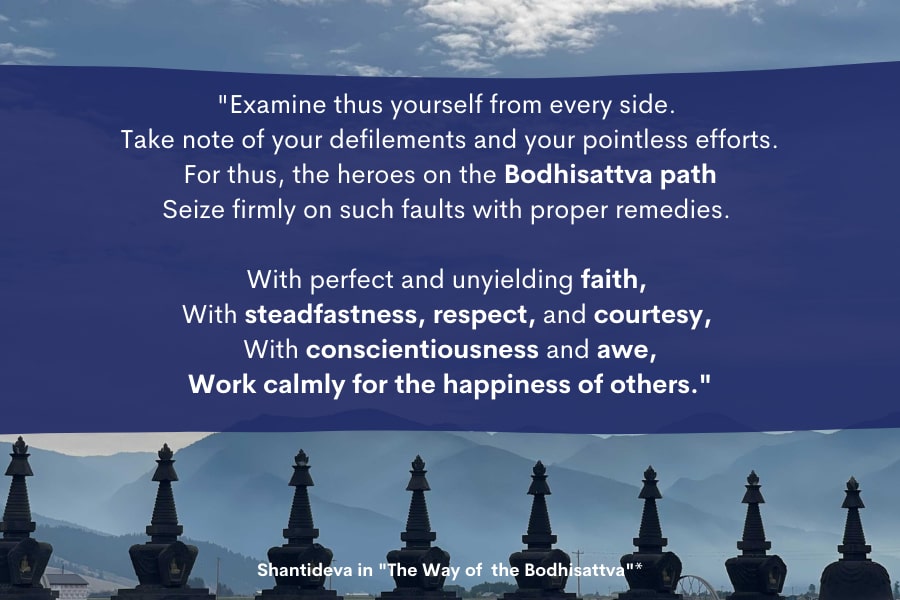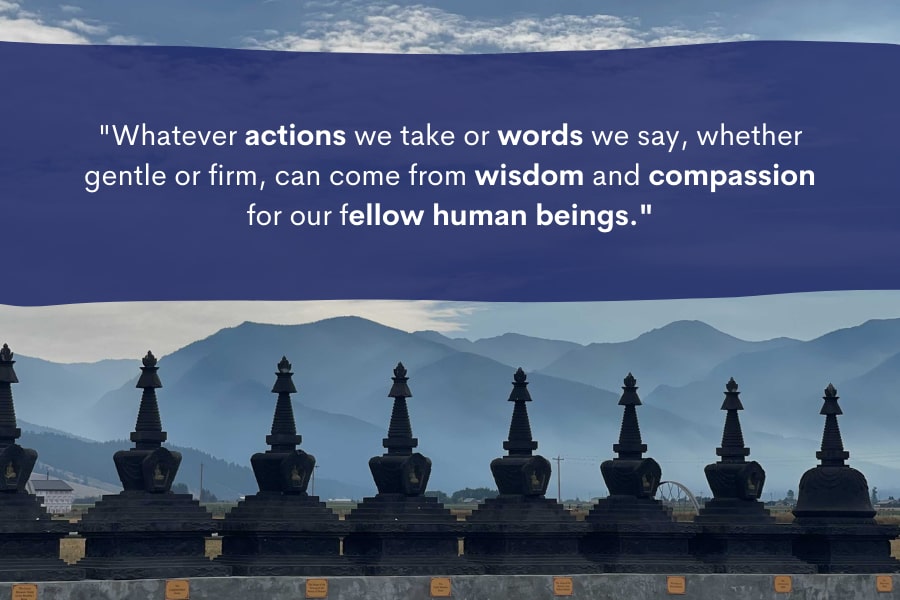The demands and pace of modern life tend to leave us with little time to think through all of our decisions and actions. Even on normal-seeming days, we wake up to a mountain of decisions: what to eat, what to wear, how and with whom to communicate, and how we show up at work and with our loved ones. With this constant decision-making, it’s easy and understandable to fall into autopilot and make our decisions without a great deal of thought.
We aren’t here to tell you what to eat, what to wear, or who to talk to. But if enlightenment is our goal, the bodhisattva path will play the role of our moral North Star, always showing us the way to get there most efficiently. HH Dalai Lama says, “Sooner or later we’ll all become enlightened … Better it be sooner!” Then he laughs uproariously at his own joke.
Bodhisattva Definition
First, how do we say it? Bodhisattva pronunciation is as follows: bow dee saat va. Secondly, what does it mean to be a bodhisattva. Simply put, a bodhisattva is someone who has bodhicitta mind, which is a heart/mind of awakening. It’s knowing that we’re all fellow waves on one ocean and acting from that. It’s a combination of wisdom and compassion. In Sanskrit, bodhisattva meaning is translated as someone who is engaged on the path to enlightenment.
Not quite there yet? Neither are we! Not to worry, that’s a mind that we can cultivate! First, we develop bodhicitta mind, the wish to liberate beings from suffering and bring them to enlightenment. Then we engage bodhicitta through the practices of the Six Perfections, which are generosity, discipline, patience, diligence, concentration (or meditation), and wisdom, which is the realization of emptiness—the ultimate nature of all things. Read more on those HERE.
If we choose the bodhisattva path, we have our values and goals laid out before us. A “high road” of sorts, where we focus on love, compassion, patience, and generosity above worldly possessions and prestige. There’s no need to be fully enlightened beings before starting this path. We can start now!
There are numerous resources regarding how to be a bodhisattva and bodhisattva meaning. However, The Way of the Bodhisattva, a translation of the Bodhicaryāvatāra by Shantideva, has been a favorite for centuries in all schools of Buddhism. On the one hand its guidance is a pure emanation of the Buddha, who certainly succeeded in the Bodhisattva and enlightenment departments! But also The Way of the Bodhisattva gives lots of great, real-life examples to which we all can relate. Those examples stick in your mind as you go about your day.
For those of us wondering, “Who was Shantideva, and how did he know the way?” Here’s a snippet and some historical context. Historians have varying ideas on the details of Shantideva’s life. Generally, it’s accepted that he was born a prince in India, he was drawn to Buddhism and especially the Mahayana path from a young age, and that he held religious teachers and monastics in high regard. With a heart focused on enlightenment, he was known for his deep care for societal outcasts. Rather than a life of royalty, he became a monk and was ordained at the monastic university of Nālandā. Ironically, he was not known for being a great student. Towards the end of his schooling, he was asked to share something new with the other monks. Much to their dismay, what he shared was profound. Word spread quickly about Shantideva and he gained hundreds of disciples and wrote three books.

Originally in Sanskrit, The Way of the Bodhisattva was quickly recognized as a masterpiece and translated into Tibetan shortly after it was written. This emphasizes its importance and relevance to Tibetan Buddhism.
At Namchak, we also hold this book dear. Khen Rinpoches teaches an annual retreat on The Way of the Bodhisattva, where he chooses a chapter or two to review with students. He recently reviewed chapters 4 (Carefulness) and 5 (Vigilant Introspection). Here’s an excerpt:
“Examine thus yourself from every side.
Take note of your defilements and your pointless efforts.
For thus, the heroes on the Bodhisattva path
Seize firmly on such faults with proper remedies.
“With perfect and unyielding faith,
With steadfastness, respect, and courtesy,
With conscientiousness and awe,
Work calmly for the happiness of others.” *

As we navigate our daily mountain of decisions, we can use The Way of the Bodhisattva or any teachings about the bodhisattva path as a guide for all of our interactions. Let’s say you’re at the store and a believer in us all wearing masks. Someone is having just as much conviction that we shouldn’t wear masks. Or vice versa? How would the Buddha work with that other person? How would he hold that person in his heart, whatever actions or words he chose? That’s not to say we must agree with that person. We can choose to disagree AND disagree with compassion. Whatever actions we take or words we say, whether gentle or firm, can come from wisdom and compassion for our fellow human beings. If we all did that, imagine how the world would be!
We hope you will join us on the path through Retreats and Events or Learning Circles. For today, let’s make time for introspection, and contemplate how we can, “Work calmly for the happiness of others.”*
Curious about bodhisattva vows? Read more about them HERE.
**From The Way of the Bodhisattva by Shantideva © 1997, 2006 by Association Padmakara. Reprinted in arrangement with Shambhala Publications, Inc.
